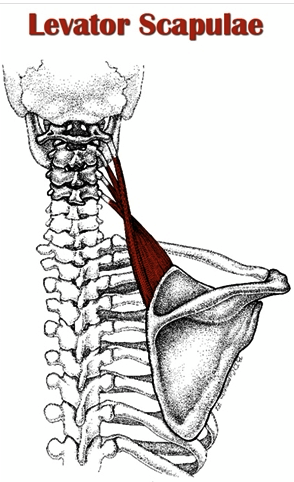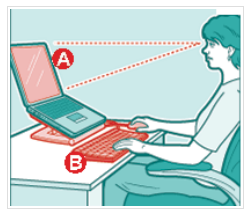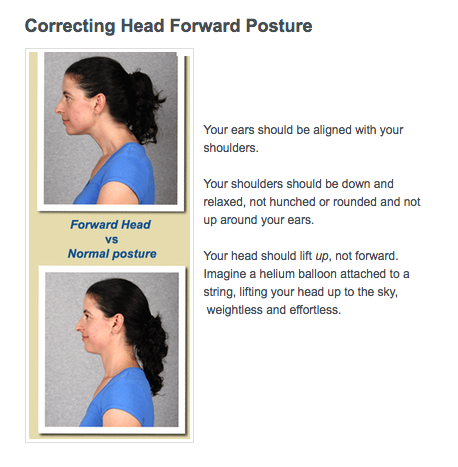|
by Beverly Greer, RMT When you wake up in the morning with a crick in your neck, or feel a burning on the top of your shoulder blade, or have trouble turning your head to look behind you when you're driving, the culprit may be your Levator Scapula! The Levator Scapula starts out as four little muscles attached to the sides of the first four vertabrae in your neck. Then they join together into one muscle and end up attached to the top of your shoulder blade. There is a levator scapula muscle on both sides of your neck. This isn't the biggest muscle on the neck, but it sure does a lot of work! Like it says on the tin, Levator Scapulae elevates your scapula, aka the shoulder blade. Every time you shrug your shoulders, the levator scapula is working. Levator Scapulae also turns your neck on the same side. So if you want to look over your left shoulder, your left levator scapula is engaged. Along with other muscles at the back of the neck, levator scapula stabilizes your neck. When you are looking down to read or write, the levator scapula prevents your head from flopping forward onto your chest. Causes of Pain....Elevated ShouldersEvery time we raise our shoulders, we engage the levator scapula muscle. Most of us spend hours every day with this muscle engaged, then wonder why our neck and shoulders are so tight! Typing: One of the most common causes of levator scapula pain is working on a keyboard that is positioned too high. When typing, your shoulders should be down and relaxed, your elbows should be at a 90 degree angle, and the keyboard should be level with your forearms. Either use a keyboard tray, or elevate your chair. Just be sure your feet are flat on the ground or on a footstool. Try this experiment. Stand behind a friend who is working with a proper desk setup, with the keyboard on a tray below their desk. Rest your hands on their shoulders. Now have them move their hands up to the desktop, as if their keyboard is there. You should feel their shoulders raise as they do this. Now imagine working for 8 or 9 hours a day like this, with the shoulders raised and the levator scapula engaged. Pain, stiffness and burning at the top of the shoulder blade is often caused by prolonged use of the levator scapula. Laptops: Working on a laptop is especially problematic. In order to have the screen at eye level, you must raise your shoulders to reach the keyboard. In order to work on the keyboard with your shoulders down, you must bend your head forward in order to see the screen, which as we mentioned earlier, also engages the levator scapula! If your laptop is your primary computer, or if you are going to be working on it for more than an hour or two, it is strongly recommended that you invest in an external keyboard. Elevate the laptop on a stand so that the screen is arms length away and just below your line of vision. Either use a keyboard tray to hold the keyboard so your shoulders are down and relaxed, or elevate your chair. Just make sure your feet are flat on the floor or a footstool. Driving: Long hours of driving with your hands near the top of the steering wheel, in the '10 and 2' position cause the levator scapula to be engaged. The optimum position when driving is to have the seat slightly reclined (about 15 degrees) and the chair seat tipped forward. Keep your elbows slightly bent and your hands at the '9 and 3' position. The middle of the headrest should be level with the top of the ear. Working with your arms raised: Working with your arms raised above your head for prolonged periods of time can also irritate the levator scapula. To help reduce neck pain, stabilize your shoulder blade when you raise your arm.
The muscles at the front of the neck vertebrae, the longus capiti and colli, prevent the head from falling backwards. The scalene muscles, located at the sides of the neck, prevent the head from wobbling from side to side. The splenius muscles, and our old friend the levator scapula, work from the back of the neck to prevent the head from falling forward onto your chest. Because we spend so many hours a day reading or working on computers with our heads bent forward, the poor levator scapula is constantly straining to keep our heads from falling onto our chests. The more forward the posture of our head is, the harder this muscle has to work. Remember when I said the average head weighs about 12 pounds? That's with properly aligned posture. The farther forward your head is, the more it weighs! If you have head forward posture, your levator scapula is stretched tight all day long, trying to stabilize a 42 pound head! Symptoms and CausesHead forward posture can do more damage than causing a tight, overworked levator scapula muscle. It can also:
Head forward posture is most commonly caused by:
Stiff Neck? Blame Levator Scapula!8/20/2012
23 Comments The 'pecs' are your chest muscles. Tight, short pecs cause rounded shoulders and can increase head forward posture.
Credit: Doug Alexander Kelsey Cooper
1 Comment
|
Your Friendly Neighbourhood RMTWe love providing massage therapy to the best 'hood in Toronto! Archives
July 2016
Categories |












 RSS Feed
RSS Feed
